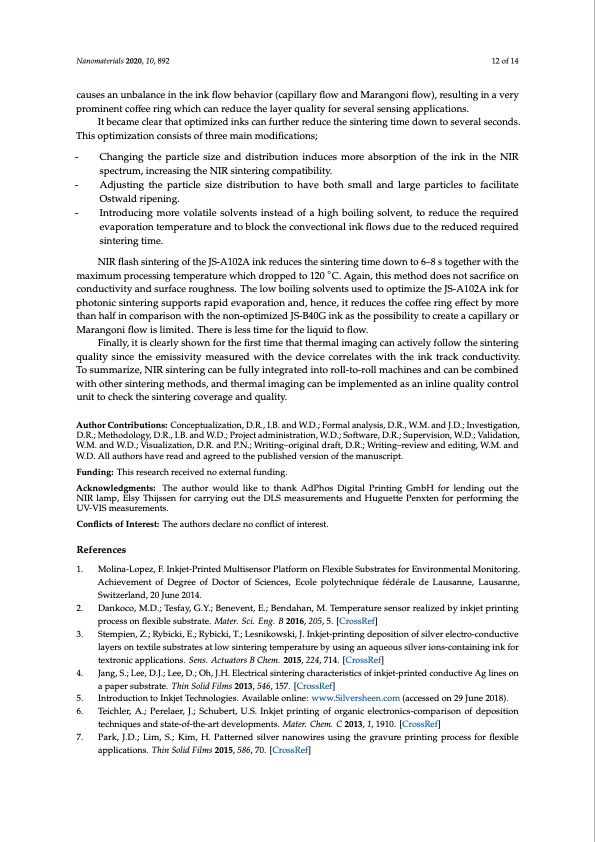
PDF Publication Title:
Text from PDF Page: 012
Nanomaterials 2020, 10, 892 12 of 14 causes an unbalance in the ink flow behavior (capillary flow and Marangoni flow), resulting in a very prominent coffee ring which can reduce the layer quality for several sensing applications. It became clear that optimized inks can further reduce the sintering time down to several seconds. This optimization consists of three main modifications; - Changing the particle size and distribution induces more absorption of the ink in the NIR spectrum, increasing the NIR sintering compatibility. - Adjusting the particle size distribution to have both small and large particles to facilitate Ostwald ripening. - Introducing more volatile solvents instead of a high boiling solvent, to reduce the required evaporation temperature and to block the convectional ink flows due to the reduced required sintering time. NIR flash sintering of the JS-A102A ink reduces the sintering time down to 6–8 s together with the maximum processing temperature which dropped to 120 ◦C. Again, this method does not sacrifice on conductivity and surface roughness. The low boiling solvents used to optimize the JS-A102A ink for photonic sintering supports rapid evaporation and, hence, it reduces the coffee ring effect by more than half in comparison with the non-optimized JS-B40G ink as the possibility to create a capillary or Marangoni flow is limited. There is less time for the liquid to flow. Finally, it is clearly shown for the first time that thermal imaging can actively follow the sintering quality since the emissivity measured with the device correlates with the ink track conductivity. To summarize, NIR sintering can be fully integrated into roll-to-roll machines and can be combined with other sintering methods, and thermal imaging can be implemented as an inline quality control unit to check the sintering coverage and quality. Author Contributions: Conceptualization, D.R., I.B. and W.D.; Formal analysis, D.R., W.M. and J.D.; Investigation, D.R.; Methodology, D.R., I.B. and W.D.; Project administration, W.D.; Software, D.R.; Supervision, W.D.; Validation, W.M. and W.D.; Visualization, D.R. and P.N.; Writing–original draft, D.R.; Writing–review and editing, W.M. and W.D. All authors have read and agreed to the published version of the manuscript. Funding: This research received no external funding. Acknowledgments: The author would like to thank AdPhos Digital Printing GmbH for lending out the NIR lamp, Elsy Thijssen for carrying out the DLS measurements and Huguette Penxten for performing the UV-VIS measurements. Conflicts of Interest: The authors declare no conflict of interest. References 1. Molina-Lopez, F. Inkjet-Printed Multisensor Platform on Flexible Substrates for Environmental Monitoring. Achievement of Degree of Doctor of Sciences, Ecole polytechnique fédérale de Lausanne, Lausanne, Switzerland, 20 June 2014. 2. Dankoco, M.D.; Tesfay, G.Y.; Benevent, E.; Bendahan, M. Temperature sensor realized by inkjet printing process on flexible substrate. Mater. Sci. Eng. B 2016, 205, 5. [CrossRef] 3. Stempien, Z.; Rybicki, E.; Rybicki, T.; Lesnikowski, J. Inkjet-printing deposition of silver electro-conductive layers on textile substrates at low sintering temperature by using an aqueous silver ions-containing ink for textronic applications. Sens. Actuators B Chem. 2015, 224, 714. [CrossRef] 4. Jang, S.; Lee, D.J.; Lee, D.; Oh, J.H. Electrical sintering characteristics of inkjet-printed conductive Ag lines on a paper substrate. Thin Solid Films 2013, 546, 157. [CrossRef] 5. Introduction to Inkjet Technologies. Available online: www.Silversheen.com (accessed on 29 June 2018). 6. Teichler, A.; Perelaer, J.; Schubert, U.S. Inkjet printing of organic electronics-comparison of deposition techniques and state-of-the-art developments. Mater. Chem. C 2013, 1, 1910. [CrossRef] 7. Park, J.D.; Lim, S.; Kim, H. Patterned silver nanowires using the gravure printing process for flexible applications. Thin Solid Films 2015, 586, 70. [CrossRef]PDF Image | Nanoparticle Inkjet Inks for Near-Infrared Sintering

PDF Search Title:
Nanoparticle Inkjet Inks for Near-Infrared SinteringOriginal File Name Searched:
nanomaterials-10-00892.pdfDIY PDF Search: Google It | Yahoo | Bing
Turbine and System Plans CAD CAM: Special for this month, any plans are $10,000 for complete Cad/Cam blueprints. License is for one build. Try before you buy a production license. More Info
Waste Heat Power Technology: Organic Rankine Cycle uses waste heat to make electricity, shaft horsepower and cooling. More Info
All Turbine and System Products: Infinity Turbine ORD systems, turbine generator sets, build plans and more to use your waste heat from 30C to 100C. More Info
CO2 Phase Change Demonstrator: CO2 goes supercritical at 30 C. This is a experimental platform which you can use to demonstrate phase change with low heat. Includes integration area for small CO2 turbine, static generator, and more. This can also be used for a GTL Gas to Liquids experimental platform. More Info
Introducing the Infinity Turbine Products Infinity Turbine develops and builds systems for making power from waste heat. It also is working on innovative strategies for storing, making, and deploying energy. More Info
Need Strategy? Use our Consulting and analyst services Infinity Turbine LLC is pleased to announce its consulting and analyst services. We have worked in the renewable energy industry as a researcher, developing sales and markets, along with may inventions and innovations. More Info
Made in USA with Global Energy Millennial Web Engine These pages were made with the Global Energy Web PDF Engine using Filemaker (Claris) software.
Infinity Turbine Developing Spinning Disc Reactor SDR or Spinning Disc Reactors reduce processing time for liquid production of Silver Nanoparticles.
| CONTACT TEL: 608-238-6001 Email: greg@infinityturbine.com | RSS | AMP |